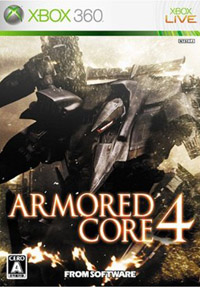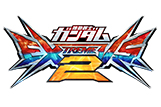Reviews: Armored Core 4 (7/10)
Posted on : 07-09-2009 | By : Cacophanus | In : Reviews
Hardware: PlayStation 3, Xbox 360
2
 Set in a not too distant future, the planet has gone to hell in a hand basket. Global environmental catastrophe is very much a reality and warring corporations now pretty much run the planet, under the false pretences of Pax Economica. To meet the ruthless needs of profiteering corporations, mercenaries by the name of Nexts pilot massive and customisable war machines by the name of armored cores, or ACs for short.
Set in a not too distant future, the planet has gone to hell in a hand basket. Global environmental catastrophe is very much a reality and warring corporations now pretty much run the planet, under the false pretences of Pax Economica. To meet the ruthless needs of profiteering corporations, mercenaries by the name of Nexts pilot massive and customisable war machines by the name of armored cores, or ACs for short.
Nexts are also a new type of human – they directly interface with their mechanical avatars via their brain stem and consequently have unparalleled control over their AC.
The focus of the game is to undertake missions in a third person action setting, which pay money for you to buy more parts and undertake more challenging though better paying sorties. Now that the player is a next level pilot, the emphasis is much more on refined control than in previous iterations.
It’s a hard game though and even for someone who has played all the games since their 1997 inception. However, learning curves in games are funny beasts, some people react negatively and dismiss a game out of hand because it doesn’t empower them in the way their little mental kingdom thinks it should. Others, like me, enjoy trying new things and pushing themselves to the limit of their feeble cognisance.
Armored Core 4 will make you feel very stupid for a fair while, and in all fairness in the context of the game; you are stupid. There’s a massive amount to take in and at the beginning of the game you’ll lack the skill base the game requires. This be the learning curve and you can either cuss at the game or sit down and learn something new.
Like every Armored Core game before it, Armored Core 4 is split into two parts, customisation and action-based gameplay. Neglecting either will get you in a lot of trouble very quickly. Customisation is much more direct than the previous iterations, mainly because weapons and parts aren’t all that quirky and mimic real world sensibilities. So equipping a gatling cannon over a machine gun means that logically a gatling cannon won’t need to reload a magazine whereas a machine gun will (something the simplified HUD indicates fluidly).
Action has been given a massive reworking though. Instead of a cramped FCS lock box that has to be pointed at a target in order to acquire a lock, the whole screen now fulfils that task. Generator capacity is also far more forgiving; where in the past running your energy capacity dry meant sitting prone as you recharged (known as “red lining” amongst the AC throng) now you never run dry. In addition, boosting along the ground is free and all legtypes now hover on water. In basic changes alone, Armored Core 4 gives huge concessions to newer players and rethinks the fundamental foundations of the last decade of gameplay. However, that’s not all.
Many of the tournaments since Armored Core 2 had players making quick uses of over boost; a very powerful forward thrust that ate at energy consumption. The point of this manoeuvre being to break the FCS lock of your opponent and place you in an advantageous position once executed. The problem with this, since Armored Core 3 at least, is that not all cores were equipped with over boost. Plus, it was a clumsy hack on the part of the player to exploit the game in a human versus context.
Armored Core 4 changes this by making the quick over boost manoeuvre an innate omni directional one. This new quick boost, or QB, ability is amazingly executed and literally allows you to dodge bullets. Consequently the game speed is now verging on moderately bonkers.
This is not to say that over boost isn’t present, that’s still around and suitably powered up too. You can know cruise at a cool 1000kmh but this functionality is slightly different, which brings me onto primal armor.
The increased game speed and increased intensity of enemy weapons fire means the player needs some kind of protection. This takes the form of a spherical energy shield by the name of primal armor. In the previous games this functionality was covered by options parts that shielded you from both energy and solid based weapons fire. The difference now is that the shield is much stronger, it can absorb most weapons fire without the player taking any damage at all, but it is finite.
Once primal armor wears out, which it does during higher power encounters, you are pretty much made of paper. Even with large amounts of armor points, or AP, compared to the previous games, without primal armor you are hugely vulnerable.
Admittedly primal armor does recharge, albeit slowly (as of Regulation 1.00, but more of that later), but without it you are basically naked in gameplay terms. Interestingly, over boost now uses primal armor as its main source of sustenance. This means boosting at 1000kmh leaves you relatively naked at the end of the manoeuvre. Hardly ideal but there are instances when this can be useful and, coupled with judicious QBing, you can survive most enemy encounters with practice. The point here is that these opposing facets force the player to increase their competence at the game.
Primal armor also feeds off your generator now, or more accurately off the Kojima Particle output from your generator. The usage of the Kojima name is most probably from Armored Core 4’s lead 3D designer, Yuzo Kojima. Interestingly, Shoji Kawamori is no longer present in the credits, considering he helmed the mechanical design since the 1997 original his absence is noticeable.
Kojima Particles, or KP, are balanced against the generator’s energy output. This means that you can either have lots of energy for QBing at the expense of PA, or have loads of PA but move like a veritable brick. It’s a sage balancing choice and considering the various weight classes the game’s customisation offers it makes a lot of sense to have the energy and PA play off each other like this.
Kojima technology also allows for some pretty interesting weapons, namely the Kojima rifle and cannon. Their initial stats are somewhat deceptive because they display the weakest state. Once charged a Kojima cannon can utterly cripple a Next AC, two shots can kill almost anything outright. Thankfully, both weapons only have four rounds and are quite heavy. These aren’t available from the off though, but after the player completes the game on Normal difficulty (the default setting) and then replays the Silent Avalanche mission on Hard.
Alongside the Kojima weaponry is a new part category that plays a subtle though simultaneously immense role in gameplay. These are your stabilisers and they are situated all over your AC. They have two main functions, to absorb weapon fire impacts and adjust your centre of mass. In that, having a lopsided AC in terms of weight distribution means you’ll have a control bias in whatever direction the weight leans toward. Ideally, you want your centre of mass positioned to negate such a bias. However, doing so often reduces your resilience to being stunned when hit by higher velocity weapons fire (especially of the solid variety). In the singleplayer it’s not that noticeable but against human opponents online, it’s a very big deal if you don’t sort your stabilisers out.
The missions themselves are clever as well, not so much in level design, but more in terms of the requirements for customisation and the manner in which you execute your design in gameplay terms. For instance, in the mission Marche au Supplice you face three next ACs along with buddies, but on Hard you face four alone. You’re lucky to last longer than ten seconds with most setups, until you realise that dual wielding the back mounted hi-laser cannons gives you the chance to inflict “massive damage” in a short space of time. The part you are awarded upon completion is the triple laser cannon that looks like a beautiful mechanical wing (you can dual wield these too, making your AC look truly angelic). Essentially, you are awarded a pertinent part for the successful completion of the mission. Missions are diverse though, whilst there are a few instances of the same environment being used more than once, the objectives are kept varied.
Visually, it’s an acquired taste. It’s incredibly stylised in terms of visual effects and the ACs themselves are exquisitely modelled, but the environments can be occasionally rather spartan. Admittedly, speeding across an ocean taking out warships isn’t a very complex environment but it doesn’t need to be. On the flipside, you have a mission set within a reactor, with a complex array pipes and shielding everywhere. Yet, there is still a sense of haunting emptiness. To be fair, this has been the case since the 1997 original and is now becoming more of a From Software artistic stance than any kind of notable oversight but it’s not for everyone (though the difficulty has already covered that).
The final and most massive addition to the game is the online multiplayer, something that players have been begging for since, well, nearly ten years ago. It took me about two minutes to register a free account and less than thirty seconds to get into a game and start kicking ass. In short, online is very simple to use and stable with it. Being able to enter the fray with seven other players is fantastic fun. The versus stages are decent too, with some giving good cover for those tactically inclined.
Following on from online is the implementation of a Regulation file. Upon starting the game you are set to Regulation 1.00. However, newer Regulation files are planned to be released. At present we already have Regulation 1.10 available, which has changed the speed at which primal armor refreshes. In an interesting choice of functionality, you can choose which file you use in gameplay.
Overall, Armored Core 4 is a very accomplished and well thought out game but it’s by no means inherently inclusive. If you want some mindless point and shooting action, with little or no skill involved, then this isn’t your game. However, if you are a more thoughtful and patient individual that doesn’t mind learning something new in terms of gameplay, then you will find this richly rewarding. Considering the price tag of both the machine and the game, surely that’s what anyone should want.
Tamashii: 7/10











[…] before people get excited, Miyazaki has already directed two mainline Armored Core games, namely Armored Core 4 and Armored Core For Answer (shown above). Both did poorly in terms of sales as well as critically […]
[…] before people get excited, Miyazaki has already directed two mainline Armored Core games, namely Armored Core 4 and Armored Core For Answer (shown above). Both did poorly in terms of sales as well as critically […]